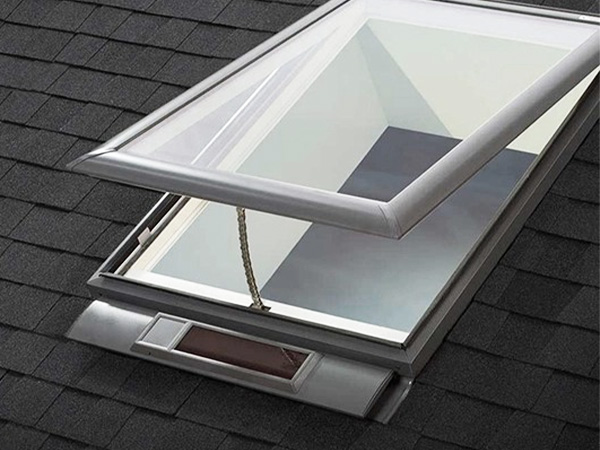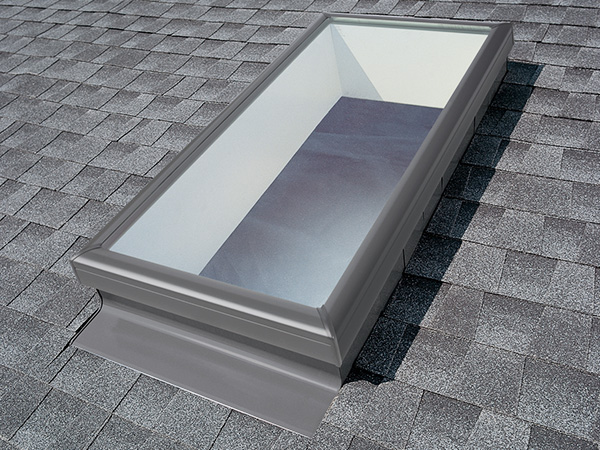

Let the Sunshine in With Skylights
Skylights are a great idea when you’re craving a bit more natural light (or in some cases, added ventilation) in your home. During the winter, a little extra light from above seems like the perfect antidote to the gloom. However, skylight installation isn’t the easiest DIY choice, even for the experienced home improver. Here are some tips to keep in mind before you start cutting holes in your roof.
Benefits of a Skylight
Installing a skylight can add more than just additional daylight to your home. They can actually save you money and make you happier.
- Skylights can help heat your home. The added light from a skylight transmits solar heat as well as light. This means you can turn down your thermostat (and electric lighting) and let mother nature help out however, you need to plan strategically if you live in a warm climate.
Keep in mind that you should take your local climate into consideration when picking out a skylight in order to get the most benefit. Energy-efficient skylights can help keep your house warmer in winter and cooler in summer – but not all offer this perk. You can look for different manufacturer glazes for different climate conditions, like heat-absorbing tints, insulated glazing, low-emissivity (low-e) glazing, or even translucent insulation between layers of glazing. You can pick glazing that traps heat inside your home to help heat it and select options that are “thermally broken” (meaning no piece of hardware in the skylight connects the outside to the inside of the home) to lessen heat loss.
- Check out that view. The addition of a skylight can lead to dreamy days watching the swaying of the trees overhead. Adding a unique view of nature from inside your home can improve your mood and reduce stress.
- Add value to your home. A set of beautiful skylights can add an improved aesthetic to your home. By adding natural light, you’re a step further down the line of making that boring dark space into a room you want to spend time in. Or with increased ventilation, a musty bathroom becomes fresh and clean feeling.

Types of Skylights

Skylights come in all sorts of shapes and sizes to solve different construction needs.
- Fixed: Like their name implies, these types of skylights don’t open, but are fixed along a roof. Best when you don’t need to add ventilation, these types of skylights are also great for adding to high, vaulted ceilings. Or bring light to dark spots in your home, like hallways and stairwells with products like skylights from VELUX which can transform gloomy areas into bright and open spaces.
- Vented: This type of skylight lets you open the skylight a bit (or a lot) either through manual or mechanical devices (even solar powered). They’re a great pick for rooms that need extra ventilation like bathrooms, kitchens, or even laundry rooms.
- Tubular: These are great when you’re trying to capture light into a tight space below a traditional roof attic. They work by adding mirrors to a cylinder, bouncing light down into your home. This type of skylight doesn’t offer ventilation or views.
Different Skylight Features
- Glazing: The glazing on a skylight can impact the energy efficiency and whether you’d like to heat or cool the space below a skylight. Some coatings can let light and heat in but not let heat back out, helping you heat your home – helpful in the cold days of winter. Alternatively, you can look for coatings designed to help you cool your home while still adding more daylight. Look for skylights with a low Solar Heat Gain Coefficient (SHGC), specifically one lower than 0.3. A low SHGC helps to minimize solar heat gain and helps to prevent overheating.
- Materials: Most are made of a wood, vinyl, or metal frame set around tempered glass. Some designs include a dome cover to assist in letting rain or snow run off and not pool on top of the glass. You can also find some with plastic instead of glass, which can lower the weight and cost, but also have a higher chance for scratching.
- Solar-powered open and close: To assist in ventilation when rooms get too hot, some come with a solar-powered mechanism to open or close at the press of a button.

Sizing and Placement
Skylights come in all shapes and sizes, and fixed styles can typically be installed in vertical or horizontal orientation, to suit your home’s design and to capture light and the view in the most aesthetic way possible. A good rule of thumb is to choose ones that equal to a maximum of 5% of the floor area (where rooms have many other windows). In rooms that have no other windows, skylights should equal a maximum of 15% of the total floor area.

Choose your type and size depending on your individual home’s design, including the roof style. Depending on the style of your roof, you may need certain mountings, like curb- or flush-mountings. Curb mountings have your skylight sit “on top” of your roof, while flush-mountings set the skylight flush with the roof, so you won’t see the skylight from the outside as much. Some may require flashing, while others will not.
- For flat roofs: You can install on a flat roof, but you will need to take care to provide for water runoff to avoid leakage.
- For shingle roofs: You can install almost any type of skylight on a shingle roof, but it’s best to install them only on stick-framed roofs as they are better suited for skylight needs. Stick-framed roofs with rafters spaced as much as four-feet apart have ample room for installing skylights. With truss-framed roofs, you can install skylights, but more planning is required, and a professional is highly recommended. Trusses aren’t designed to be cut and you could compromise your roof’s structural integrity in the search for some additional natural lighting.
- For metal roofs: For standing-seam and other metal roofs, you can install a skylight – typically a curb-mounted and deck-mounted one works best. You should use a professional to ensure proper sealing and flashing are installed.
Note: No matter where you place it, you could still encounter issues with leakage. If there isn’t enough slope for drainage on your roof, you could find that any skylight is problematic.
You should also consider the direction your roofline faces and your skylight goals. If you are looking for maximum daylight capture, skylights with unobstructed views of the southern or western sky will be most efficient. For rooms you want to add light to, but also keep cooler, installing skylights on a north-facing roof can be the best choice.
Should You Install Your Own?
Installation is usually left to experienced professionals or very advanced DIYers. Even so, you should keep in mind that a poor skylight installation (even by a professional) can lead to issues like condensation, leakage, and subsequent water damage inside your home.
A quick rundown of what it takes to install a skylight includes the following:
- Check the roof style and slope to ensure the best drainage possible, as well as the best way to capture light and heat.
- You’ll need to install the skylight with certain considerations to avoid problems like leakage.
- Install it into the roof's surface.
- Use a raised, watertight lip called a "curb" and flashing.
- Thoroughly seal the edges (this isn't a place to skimp).
- Follow all the guidelines from the manufacturer.
- In addition, use sheet waterproofing over the flanges. This should typically go under the roofing material when you’re looking to prevent ice dams. It helps prevents leaks.
Still not sure what it takes? Try watching this installation video from VELUX for a curb-mounted skylight and see if it’s something you could tackle.
McCoy's Experts Can Help Shed Light on Skylights
Unsure if installing a skylight is a DIY you should D-I-Do? Come by your local McCoy’s and talk to our friendly experts. They can help you decide on the right skylights for your project and give you their best assessment to make sure you’re only going to bring light and good views into your home with a new skylight – not rain and headaches.

